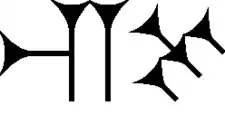Zi (cuneiform)
The cuneiform zi sign is a common multi-use sign of the Epic of Gilgamesh, the 1350 BC Amarna letters, and other cuneiform texts. It also has a sumerogrammic usage for ZI in the Epic of Gilgamesh. The structure of the cuneiform sign is like its twin, Gi (cuneiform), ![]() .
.

Cuneiform for ze, zi, and ZI; digitized form.
.jpg.webp)
Old Assyrian cuneiform for ze, zi, and ZI.
_of_Egypt%252C_matching_fragment_in_British_Museum_-_Oriental_Institute_Museum%252C_University_of_Chicago_-_DSC07018.JPG.webp)
EA 26, fragment (Obverse).
(high-resolution expandable photo)
(Last flat-surface 5-lines on fragment (Para IV), lines 30–34.
(An Amarna letter that uses zi.)
(high-resolution expandable photo)
(Last flat-surface 5-lines on fragment (Para IV), lines 30–34.
(An Amarna letter that uses zi.)
Wikimedia Commons has media related to Zi (cuneiform).
The "zi" sign has the syllabic usage for ze and zi, and a Sumerogram usage for ZI. Alphabetically "zi" can be used for z ("z" can be interchanged with any "s"); and "zi"/"ze" can be used for i, or e. In Akkadian, all 4 vowels, a, e, i, u are interchangeable with each other.
Epic of Gilgamesh usage
The zi sign usage in the Epic of Gilgamesh is as follows: ze-(6 times); gi-(46), ZI-(32 times).[1]
References
- Parpola, 1971. The Standard Babylonian Epic of Gilgamesh, Sign List, pp. 155-165, no. 084, p. 156, "zi".
- Moran, William L. 1987, 1992. The Amarna Letters. Johns Hopkins University Press, 1987, 1992. 393 pages.(softcover, ISBN 0-8018-6715-0)
- Parpola, 1971. The Standard Babylonian Epic of Gilgamesh, Parpola, Simo, Neo-Assyrian Text Corpus Project, c 1997, Tablet I through Tablet XII, Index of Names, Sign List, and Glossary-(pp. 119–145), 165 pages.
This article is issued from Wikipedia. The text is licensed under Creative Commons - Attribution - Sharealike. Additional terms may apply for the media files.